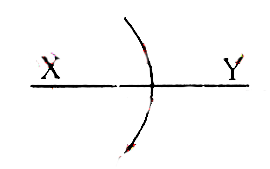A convex refracting surface of radius of curvature separates two media of refractive indices . An object is placed in the first medium at a distance of from the refracting surface. Calculate the position of image formed.
The correct Answer is:At in denser medium
To solve the problem of finding the position of the image formed by a convex refracting surface separating two media with different refractive indices, we can use the lens maker's formula for refraction at a spherical surface. Here's a step-by-step solution:
Step 1: Identify the given values
- Radius of curvature (R) = +20 cm (positive for a convex surface)
- Refractive index of the first medium (μ1) = 4/3 ≈ 1.33
- Refractive index of the second medium (μ2) = 1.60
- Object distance (U) = -200 cm (negative as per the sign convention)
Step 2: Use the refraction formula
The formula for refraction at a spherical surface is given by:
μ2−μ1R=μ2V−μ1U
Where:
- V = image distance (what we want to find)
- U = object distance (given as -200 cm)
- R = radius of curvature (given as +20 cm)
Step 3: Substitute the values into the formula
Substituting the known values into the formula:
1.60−4320=1.60V−43−200
Step 4: Simplify the left-hand side
First, calculate μ2−μ1:
1.60−43=1.60−1.33=0.27
Now, substituting this back into the left-hand side:
0.2720=1.60V+43200
Calculating 0.2720:
0.2720=0.0135
Step 5: Simplify the right-hand side
Now calculate 43200:
43×200=4600=1150≈0.00667
Step 6: Set up the equation
Now we have:
0.0135=1.60V+0.00667
Step 7: Isolate 1.60V
Subtract 0.00667 from both sides:
0.0135−0.00667=1.60V
Calculating the left-hand side:
0.0135−0.00667=0.00683
Now we have:
1.60V=0.00683
Step 8: Solve for V
Now, solve for V:
V=1.600.00683≈234.15 cm
Step 9: Conclusion
The position of the image formed is approximately 234.15 cm from the refracting surface in the denser medium.
- Radius of curvature (R) = +20 cm (positive for a convex surface)
- Refractive index of the first medium (μ1) = 4/3 ≈ 1.33
- Refractive index of the second medium (μ2) = 1.60
- Object distance (U) = -200 cm (negative as per the sign convention)
The formula for refraction at a spherical surface is given by:
- V = image distance (what we want to find)
- U = object distance (given as -200 cm)
- R = radius of curvature (given as +20 cm)
Substituting the known values into the formula:
First, calculate μ2−μ1:
Now calculate 43200:
Now we have:
Subtract 0.00667 from both sides:
Now, solve for V:
The position of the image formed is approximately 234.15 cm from the refracting surface in the denser medium.
Topper's Solved these Questions
- RAY OPTICSBook:PRADEEPChapter:RAY OPTICSExercise:Problem For Practice(c)
Explore 27 Videos
- RAY OPTICSBook:PRADEEPChapter:RAY OPTICSExercise:Problem For Practice(d)
Explore 35 Videos
- RAY OPTICSBook:PRADEEPChapter:RAY OPTICSExercise:Long Answer (a)
Explore 5 Videos
- PROPERTIES OF BULK MATTERBook:PRADEEPChapter:PROPERTIES OF BULK MATTERExercise:Multiple choice questions
Explore 7 Videos
- SYSTEMS OF PARTICLES AND ROTATIONAL MOTIONBook:PRADEEPChapter:SYSTEMS OF PARTICLES AND ROTATIONAL MOTIONExercise:Assertion- Reason Type questions
Explore 20 Videos
Similar Questions
A convex surface of radius of curvature 40 cm separate two media of refractive indices 43 and 1.50. An object is kept in the first medium at a distance of 20 cm from the surface. Calculate the position of the image.
View SolutionA concave spherical surface of radius of curvature 100 cm separates two media of refractive indices 1.50 and 43. An object is kept in the first medium at a distance of 30 cm from the surface. Calculate the position of the image.
View Solution
Knowledge Check
A concave spherical surface of radius of curvature 10 cm separates two medium x & y of refractive index 4/3 & 3/2 respectively. If the object is placed along principal axis in medium X then
 Aimage is always realBimage is real if the object distance is greater than 90cmCimage is always virtualDimage is virtual if the object distance is less than 90 cm
Aimage is always realBimage is real if the object distance is greater than 90cmCimage is always virtualDimage is virtual if the object distance is less than 90 cmA point object is situated in air at a distance of 20 cm from a convex refracting surface of 5cm radius. The position of the iamge is [μ=1.5]
A40 cmB30 cmC25 cmD15 cmA concave spherical surface of radius of curvature 10cm separates two mediums X and Y of refractive indices 4/3 and 3/2 respectively. Centre of curvature of the surfaces lies in the medium X. An object is placed in medium X.
AImage is always realBImage is real if the object distance is greater than 90cmCImage is always virtualDImage is virtual only If the object distance is less than 90cm.
A concave spherical surface of radius of curvature R=20cm separates two media A and B having refractive indices μA=43 and μB=32respectively. A point object is placed on the principal axis. Find the distance of the object from the surface so that its image is virtual when
(a) the object is in medium A.
(b) the object is in medium B.
View SolutionA convex surface of radiys of curvature 20 cm separates air from glass of refractive index 1.5. Find the position and the nature of the image of a small object placed at 50 cm in front of the convex surface.
View SolutionA double convex spherical glass has refractive index 1.5 and both radius of curvature 30 cm. A point object is placed at a distance of 120 cm from the spherical glass. What will be the position of the image formed ?
View SolutionA double convex lens made of glass of refractive index 1.56 has both radii of curvature of magnitude 20cm. If an object is placed at a distance of 10cm from this lens, find the position of image formed.
View SolutionAn image is formed at a distance of 100 cm from the glass surface with refractive index 1.5, when a point object is placed in the air at a distance of 100 cm from the glass surface. The radius of curvature is of the surface is
View Solution